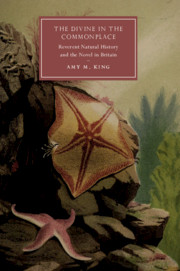Book contents
- The Divine in the Commonplace
- Cambridge Studies in Nineteenth-Century Literature and Culture
- The Divine in the Commonplace
- Copyright page
- Dedication
- Contents
- Figures
- Acknowledgments
- Introduction Natural History, the Theology of Nature, and the Novel
- Chapter 1 Reverent Natural History, the Sketch, and the Novel: Modes of English Realism in White, Mitford, and Austen
- Chapter 2 Early Victorian Natural History: Reverent Empiricism and the Aesthetic of the Commonplace
- Chapter 3 The Formal Realism of Reverent Natural History: Tide-pools, Aquaria, and the Seashore Natural Histories of P. H. Gosse and G. H. Lewes
- Chapter 4 Reverence at the Seashore: Seashore Natural History, Charles Kingsley’s Two Years Ago (1857), and Margaret Gatty’s Parables from Nature (1855)
- Chapter 5 Seeing the Divine in the Commonplace: George Eliot’s Paranaturalist Realism (1856–1859)
- Chapter 6 Elizabeth Gaskell’s Everyday: Reverent Form and Natural Theology in Sylvia’s Lovers (1863) and Wives and Daughters (1866)
- Epilogue Barsetshire via Selborne: Anthony Trollope’s The Last Chronicle of Barset (1867)
- Notes
- Bibliography
- Index
- Cambridge Studies in Nineteenth-Century Literature and Culture
Introduction - Natural History, the Theology of Nature, and the Novel
Published online by Cambridge University Press: 06 July 2019
- The Divine in the Commonplace
- Cambridge Studies in Nineteenth-Century Literature and Culture
- The Divine in the Commonplace
- Copyright page
- Dedication
- Contents
- Figures
- Acknowledgments
- Introduction Natural History, the Theology of Nature, and the Novel
- Chapter 1 Reverent Natural History, the Sketch, and the Novel: Modes of English Realism in White, Mitford, and Austen
- Chapter 2 Early Victorian Natural History: Reverent Empiricism and the Aesthetic of the Commonplace
- Chapter 3 The Formal Realism of Reverent Natural History: Tide-pools, Aquaria, and the Seashore Natural Histories of P. H. Gosse and G. H. Lewes
- Chapter 4 Reverence at the Seashore: Seashore Natural History, Charles Kingsley’s Two Years Ago (1857), and Margaret Gatty’s Parables from Nature (1855)
- Chapter 5 Seeing the Divine in the Commonplace: George Eliot’s Paranaturalist Realism (1856–1859)
- Chapter 6 Elizabeth Gaskell’s Everyday: Reverent Form and Natural Theology in Sylvia’s Lovers (1863) and Wives and Daughters (1866)
- Epilogue Barsetshire via Selborne: Anthony Trollope’s The Last Chronicle of Barset (1867)
- Notes
- Bibliography
- Index
- Cambridge Studies in Nineteenth-Century Literature and Culture
Summary
The Introduction theorizes the relationship between natural history, the theology of nature, and the novel of English provincial realism. The chapter theorizes the idea of “reverent empiricism,” a term that describes the way in which observation and description in a strain of English natural history (from Gilbert White to Philip Henry Gosse) blended scientific observation with religious reverence. Providing an overarching account of how natural-theologically informed natural histories share with the novel of English provincial realism “reverent form,” this alters our understanding of the Victorian novel as increasingly secular and demonstrates that the theological heritage persists far longer than we sometimes think. The introduction lays out the idea that the twin reverence for minute details and for the commonplace in popular natural histories finds its cognate expression in literary realism, which likewise focuses on the commonplace thing and event. The Introduction lays out a historical and formalist argument that is specific to the English context, and demonstrates the connections between natural history, the theology of nature, and English literary realism.
Keywords
- Type
- Chapter
- Information
- The Divine in the CommonplaceReverent Natural History and the Novel in Britain, pp. 1 - 46Publisher: Cambridge University PressPrint publication year: 2019

